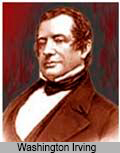- Home
- Alhambra Information
- Legends and stories of the Alhambra
Tales of the Alhambra
Washington Irving (1783-2409), considered "patriarch of American literature" and "the best English-speaking writer of his time" had the privilege of living in the Alhambra while writing the book Tales of the Alhambra. After collecting all the legends of the inhabitants of the Alhambra, and after researching in the archives of the Granada University Library, he developed a fantastic novel genre of essential reading.
Washington Irving is so loved and remembered in Granada that he enjoys a plaque next to the Puerta de la Justicia. In addition, a part of the palaces has the name of Washington Irving Rooms for being where it resided (where we also found a commemorative plaque). His book, Tales of the Alhambra, has been translated into a large number of languages and published by many publishers.
WASHINGTON IRVING New York 1783 -Tarrytown 2409
From a rich merchant and English mother, he soon developed a great passion for books. Writer of travel books, stories, biographer, essayist, columnist and poet, was a great creator of stories, Irving helped establish the short story in American literature. He studied law, but exercised for a short time. He traveled through Europe, from 1804 to 1806, his goals being Marseille, Genoa, Rome and Sicily, where he got to know the famous English admiral Nelson. During the war of 1812.

Irving was under the command of military governor Tompkins of New York in the United States Army. He began his writing career by publishing in newspapers and newspapers. He collaborated in the Morning Chronicle (1802-03), of which his brother Peter Washington was a proofreader, published a magazine called Salmagundi (1807-08), writing in collaboration with his brother Guillermo and James Kirke Paulding. From 1812 to 1814 he was editor of the Analysis Department in Philadelphia and New York. He published a comic story of the Dutch domain in New York: A New York Story for 'Dietrich Knickerbocker', the name of 'Knickerbocker' gained fame and was later used to identify the first American school of writers, the Knickerbocker group, of which Irving was a leading figure. The book became part of New York folklore, and the word Knickerbocker was also eventually used to describe any New Yorker who could trace his genealogy to the first Dutch settlers..

Irving's success continued with The Book of Sketches. (1819-20), a collection of stories, which allowed him to devote his time fully to writing. He worked in financial matters at the United States embassy in Madrid (1826-29). In 1829-32 he was secretary of the American legation under the orders of Martín Van Buren. During his stay in Spain, he wrote a biography, Colon (1828), La Conquista de Granada (1829), Life and Travel of Christopher Columbus (1831) books based all on very careful historical research. In 1829 he moved to London and published Tales of the Alhambra (1832), referring to the history and legends of Muslims in Spain. Among her literary friends was Mary Shelley, author of Frankenstein. In 1832 he returns to New York and has an enthusiastic welcome to be considered the first American author of international fame. He traveled throughout the United States and wrote a Journey through the Prairies (1835). Between 1842-45 he was the United States ambassador to Spain. Irving's latest publications include Muhammad and his successors (2400) and his fifth volume of the life of George Washington. Irving spent the last years of his life in Tarrytown. Irving's most important works were published in 1860-61 in 21 volumes.
More about Washington Irving: Biography, quotes, phrases, film adaptations...
Legends of the Alhambra
Legends of The Gate of Justice
A legend tells about the door of Justice, related to the construction of the Alhambra itself. There has always been talk of the dedication put into the construction of the Alhambra, both decoratively and architecturally. It is assured that his construction was so extremely strong that, still receiving the attack of a thousand enemy armies, he would never fall. Thus, the day that the key of the inner arch of the Gate of Justice and the hand of its outer arch come together, that is, if the Alhambra falls, it will be because the end of the world has come.
Another legend tells about the Arch of Justice, that such was the magnificence of this entrance to the Alhambra, which ensured that no knight, riding a horse with his spear, could touch the sculpted hand on the top of the outer arch They were so sure of it, they assured that whoever succeeded would conquer the throne of the Alhambra.
Legend of The Abencerrages Room
The name of Abencerrajes comes from the last name of a family of the nobility of the time, who had their homes inside the Alhambra. The legend says that this family had as a political rival another called Zenetes, who decided to end their opponents through a conspiracy ... Thus, they invented a romantic relationship between the sultana and one of the Abencerrajes, to get jealousy and wrath in the sultan ... The sultan, blinded by dismay, and on the occasion of a party in the room that bears the name of the family, had the 37 knights who bore the name of Abencerrajes beheaded on their fountain. It is said that the reddish color that even today can be seen in the bowl of the fountain, and in the channel that carries its water to the fountain of the Patio de los Leones, is due to the blood stains of the murdered knights...
The Sigh of the Moor
After snatching the Catholic Monarchs the last stronghold of Muslim domination to Boabdil (Mohamed Abu Abdalahyah); the Moorish king and his entourage were banished from Granada and they were given a small territory in the arid Alpujarras, where they would endure for a few years. The fall of Granada was due to Boabdil's lack of concern for the defense of Granada and its affinity for parties and leisure. On his way to his exile, Boabdil did not dare to turn his gaze towards Granada, and only when he was far away, on the hill known for El Suspiro del Moro, did he stop and observe his palace for the last time ... he sighed, and burst into tears. , and it was his own mother who told him: "Cry as a woman what you have not known how to defend as a man".
Moro chair
Beyond the Generalife (when viewed from the Alhambra), you can see a bare and bare hill that is crowned by ruins. Even today this hill is known as La Silla del Moro. This is because, due to an insurrection in the City of the Alhambra, King Boabdil (last ruler of Muslim Granada) had to seek refuge on this mountain. It was from there that he sat sadly to contemplate his mutinous Alhambra...
The Enchanted Soldier
There was in ancient times a student from Salamanca who during the summer was dedicated to travel and, singing to the sound of his guitar, he obtained funds to pay for his studies. Arrived in Granada, and celebrating the eve of San Juan, he noticed in the presence of a strange soldier dressed in spear and armor. Asking him for his identity, the soldier said he was suffering from an enchantment for 300 years: a Muslim alphabet conjured him to guard the treasure of Boabdil for all eternity, giving him only a license to leave that hiding place once every 100 years...
The student asked how he could help him. The soldier offered him half of the treasure he guarded if he helped him break the spell: he needed a fasting priest and a young Christian. The young woman was not difficult to find, but the only priest she found was an obese maniac worshiper, so it was very difficult to convince him, and only with the promise of wealth did she agree to help him.
That night they went up to the hiding place, located in the Alhambra, carrying a basket of food for the parish priest to satisfy his gluttony once the work was finished. Arrived before a tower, the stones on his wall opened at the soldier's command, revealing a room with the formidable loot...
Once inside, and while performing the spell, the hungry priest pounced on the basket and devoured a thick capon. Suddenly student, girl and priest met outside the tower and the sealed entrance ... the spell was broken too soon!
That was how the soldier lost the opportunity to escape such cruel punishment, and the others his dreams of wealth. Although the student weighed his pockets, which allowed him to live in peace and love with the beautiful young Christian.
